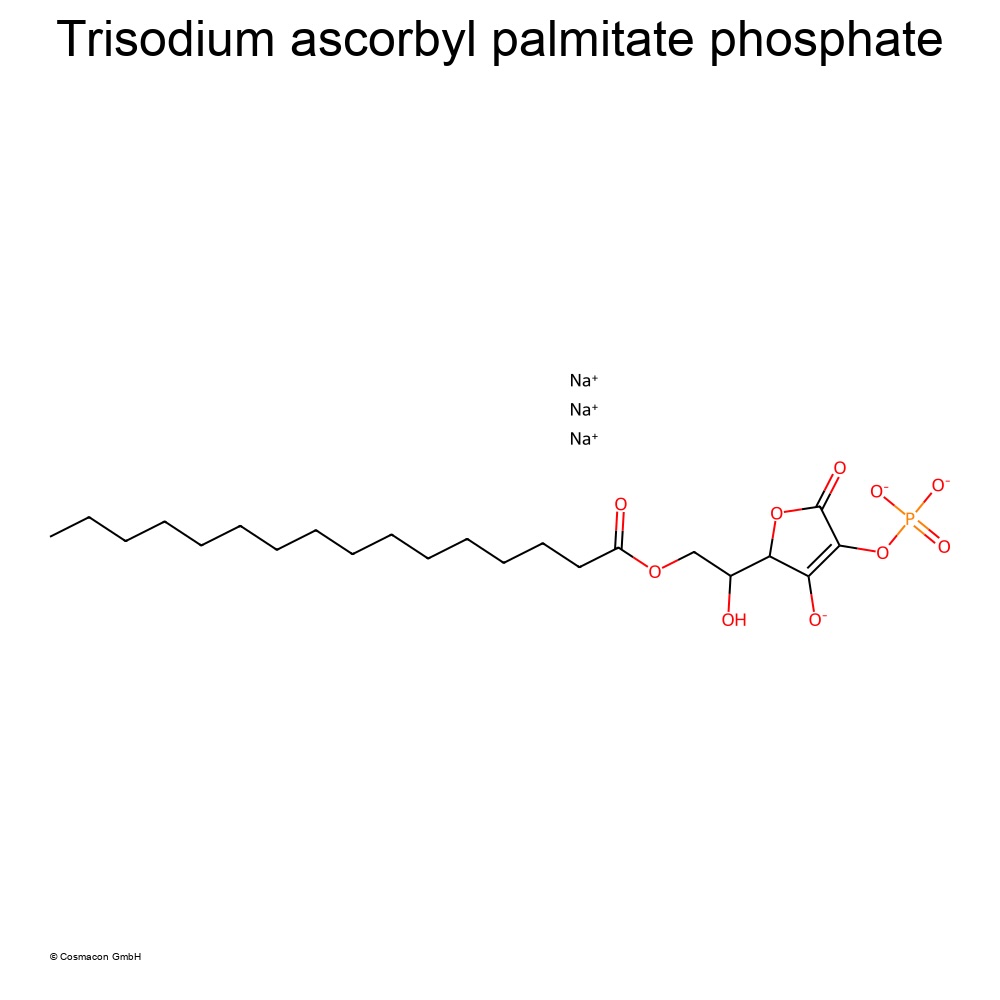Trisodium Ascorbyl Palmitate Phosphate

The world of cosmetic actives is dynamic, with new discoveries driving the development of innovative products. One of the most promising active ingredients is trisodium ascorbyl palmitate phosphate (also known as sodium ascorbyl palmitate phosphate), a stable and multifunctional variant of vitamin C. This article will explore the properties, physico-chemical characteristics, efficacy results and application possibilities of this active ingredient.
What is Trisodium Ascorbyl Palmitate Phosphate?
Trisodium Ascorbyl Palmitate Phosphate (SAP) is a water-soluble vitamin C derivative produced by chemically modifying ascorbic acid. This modification links the ascorbic acid with palmitic acid and a phosphate residue, achieving exceptional stability and enhanced bioavailability. This makes it a preferred choice for cosmetic formulations that want to utilize the efficacy of vitamin C without experiencing the drawbacks of instability or oxidation.
Physico-chemical characteristics of Trisodium Ascorbyl Palmitate Phosphate
A comprehensive understanding of the physico-chemical properties of an active ingredient is crucial for the optimal formulation of cosmetic products. Here is the most important data on Trisodium Ascorbyl Palmitate Phosphate:
· Molecular weight: Approx. 784.6 g/mol
· Solubility: Water-soluble at pH values between 5 and 7
· pH range: Stable in slightly acidic to neutral range (pH 5.0–7.0)
· Stability: highly stable to light, heat and oxidation
· Color and appearance: white to slightly yellowish powder
These properties make trisodium ascorbyl palmitate phosphate ideal for a wide range of cosmetic applications, especially in formulations that require longevity and effectiveness.
Efficacy and Recommended Use Levels
Trisodium Ascorbyl Palmitate Phosphate has been proven effective in various studies. It exhibits excellent antioxidant properties that prevent the breakdown of collagen by free radicals and promote the skin’s natural regeneration process. It also provides mild skin brightening and reduces visible signs of aging.
Efficacy Study Results:
Antioxidant protection: SAP significantly reduces oxidative stress at a concentration of 0.5–2%.
Brightening effect: Clinical tests show an improvement in skin tone at a concentration of 1%.
Anti-aging: Reductions in fine lines and wrinkles have been documented at 2–5%.
Recommended concentration: For cosmetic applications, the optimal use level is between 0.5% and 5%, depending on the desired effect and the formulation.
Possible applications in cosmetic products
Trisodium ascorbyl palmitate phosphate is an extremely versatile active ingredient that can be used in various product categories. Here are some ideas of cosmetic products where this active could shine:
Skin-lightening serums: SAP‘s water-soluble property allows for easy formulation in light, moisturizing serums.
Anti-aging creams: Thanks to its stability and antioxidant effects, SAP is excellent for anti-wrinkle creams.
Sun care products: when combined with UV filters, SAP provides added protection against UV-related damage.
Moisturizing lotions: its nourishing and protective properties make it an ideal choice for daily moisturizers.
Eye care products: SAP‘s mild but effective action makes it particularly suitable for use in the delicate eye area.
Summary and outlook
Trisodium Ascorbyl Palmitate Phosphate is an innovative active ingredient that revolutionizes the stability and efficacy of vitamin C in cosmetic products. With its antioxidant, brightening and anti-aging properties, it offers numerous possibilities for modern skin care products. Its physico-chemical properties and versatility make it a valuable addition to any formulation.
Cosmacon GmbH supports you in developing customized products that make the most of the benefits of trisodiumascorbyl palmitate phosphate. Our team of experts is at your side to create innovative and brand-relevant products that meet the requirements of your target group. Contact us to learn more about our services and turn your product idea into reality.
Literature:
Shibuya S, Sakaguchi I, Ito S, Kato E, Watanabe K, Izuo N, Shimizu T.Nutrients. 2017 Jun 22;9(7):645.